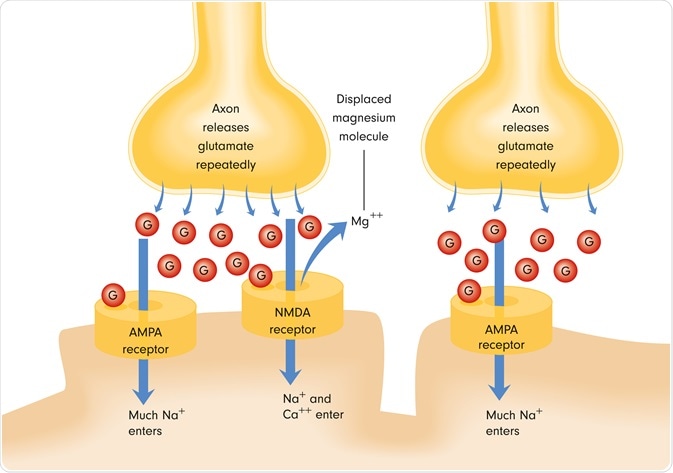N-methyl D-aspartate (NMDA) receptors are ligand-gated cation channels activated by glutamate, an excitatory neurotransmitter. These receptors are located mostly at excitatory synapses and, thereby, participate in excitatory neurotransmission in the central nervous system.

Image Credit: Emre Terim/Shutterstock.com
What are the NMDA receptors?
NMDA receptors belong to the family of ionotropic glutamate receptors, distinct from G protein-coupled receptors (GPCRs). These receptors play a pivotal role in regulating various neurological functions, such as breathing, locomotion, learning, memory formation, and neuroplasticity.
Accordingly, structural and functional impairment of the NMDA receptor can lead to neurodegenerative and cognitive disorders, including Alzheimer’s disease, Parkinson’s disease, Huntington's disease, neuropathic pain, epilepsy, and psychiatric disorders.
NMDA receptors possess certain unique features that distinguish them from other glutamate receptors, such as α-Amino-3-hydroxy-5-methyl-4-isoxazole propionic acid (AMPA). For example, NMDA receptors require two ligands, glutamate and glycine, for activation. Moreover, the receptors undergo voltage-dependent block by Mg2+ and display high permeability to Ca2+ when the Mg2+ block is removed.
Structure of NMDA receptors
NMDA receptors are composed of four distinct subunits: two glycine-binding GluN1 subunits and two glutamate-binding GluN2 subunits. These subunits are assembled in a heterotetrameric way to form a central cation-permeable channel pore.
The entire structure of the NMDA receptor is divided into four domains: an extracellular amino-terminal domain; a ligand-binding domain; a pore-forming transmembrane domain; and an intracellular carboxy-terminal domain.
Like any other receptor, NMDA receptors undergo a ligand-induced conformational change to be activated. Glutamate releases from the presynaptic terminal into the synaptic cleft at a very high concentration (about 1.1mM) and binds to the postsynaptic NMDA receptors to induce channel pore opening.
This process is known as gating. Upon activation, NMDA receptors continue to pass excitatory postsynaptic currents for tens to hundreds of milliseconds even after the removal of glutamate from the synaptic cleft.
At resting state, extracellular Mg2+ enters the receptor pore and binds to it tightly, restricting further ions' entry and preventing receptor activation. Upon sufficiently strong depolarization, Mg2+ is removed from the pore, allowing the entry of permeant ions (Ca2+).
What are the functions of NMDA receptors?
NMDA receptors play crucial roles in many neurological functions. In central synapses, these receptors regulate the structural and functional plasticity of synapses, dendrites, and neurons by activating a series of calcium-mediated signaling pathways.
Although NMDA receptors are not GPCRs, G protein-coupled receptors can indirectly influence their expression and activity through signaling pathways, impacting various physiological processes.
Synaptic strengthening
NMDA receptors play an important role in strengthening synapses, known as long-term potentiation (LTP). It is an important neurological process associated with strong memory formation.
NMDA receptors are involved in LTP in many brain regions, especially the hippocampal CA1 region. For effective LTP, calcium influx through the NMDA receptor is necessary. Calcium that enters the receptor induces activation of calcium/calmodulin-dependent protein kinase II, which in turn interacts with the NMDA receptor and thus comes into close proximity with the AMPA receptor, leading to AMPA receptor phosphorylation and the initiation of LTP.
Long-term depression (LTD) is the opposite phenomenon of LTP that causes the weakening of synapses. Mechanistically, NMDA receptors mediate LTD by dephosphorylating AMPA receptors and removing them from the synaptic membrane by endocytosis. This process also requires calcium influx through the NMDA receptor.
.jpg)
Image Credit: Andrii Vodolazhskyi/Shutterstock.com
Neuropsychiatric disorders
Deactivation of the NMDA receptor by various antagonists has been found to induce various psychiatric problems in humans, including hallucination, mood disorder, delusion, abnormal thinking, agitation, lack of motivation, cognitive deficit, and other emotional distress.
Mechanistically, antagonist-mediated blocking of NMDA receptor (hypofunctioning) leads to the excessive release of excitatory neurotransmitters (glutamate and acetylcholine) in different brain regions, which in turn causes hyperstimulation of postsynaptic neurons and subsequent induction of psychotic conditions.
Chronic hypofunctioning of the NMDA receptor, along with the persistent release of excitatory neurotransmitters, can lead to neurodegeneration. Depending on the degree and duration of NMDA receptor hypofunctioning, certain postsynaptic neurons can undergo morphological alteration. Prolonged inactivation of the receptor can induce irreversible damage to neurons in the cerebrocortical and limbic regions.
Age-related disorders
Many studies have revealed that NMDA receptors undergo a hypofunctioning state with advancing age. This hypofunctioning is basically due to a reduction in ligand-binding sites of the receptor. Interestingly, this effect is more prominent in the cortex compared to that in the hippocampus. Moreover, the expression of NMDA receptor subunits reduces with advancing age, leading to receptor hypofunctioning. Taken together, it can be said that age-related decrease in memory and learning function may be a consequence of reduced NMDA functioning.
In people with age-related neurodegenerative diseases such as Alzheimer’s disease, the degree of inactivation of the NMDA receptor is much higher than that in age-matched healthy people. Studies have proposed that hypofunctioning of the NMDA receptor can induce neurodegenerative features that are similar to Alzheimer’s disease, and amyloidosis (abnormal deposition of beta-amyloid protein) can further deteriorate the state of NMDA receptor hypofunctioning. The collective contribution of these processes can eventually trigger the onset of Alzheimer’s disease.
Therapeutic implications of NMDA receptors
Boosting NMDA receptor functioning through various drugs has become an important therapeutic strategy in preventing neurotoxicity associated with receptor hypofunctioning. For example, drugs that increase GABAA neurotransmission have been found to reduce the excessive release of acetylcholine and subsequently prevent neurotoxicity caused by NMDA receptor hypofunctioning.
Similarly, drugs that activate alpha-adrenergic receptors have been found to reduce acetylcholine release and prevent neurotoxicity and psychiatric complications caused by NMDA receptor hypofunctioning.